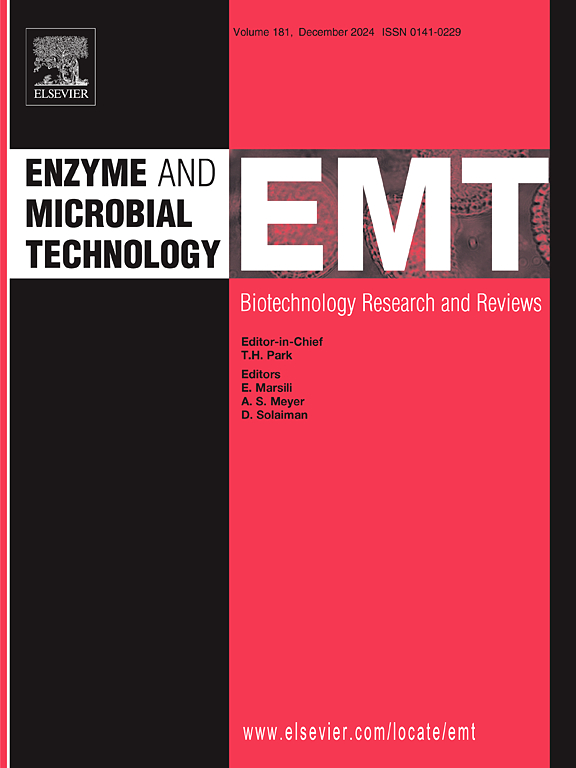通过补料分批发酵提高法菲Komagataella glucaric acid产量的代谢工程框架方法
IF 3.4
3区 生物学
Q2 BIOTECHNOLOGY & APPLIED MICROBIOLOGY
引用次数: 0
摘要
葡萄糖酸(d -糖酸)是一种属于葡萄糖醛酸衍生物的有机化合物,其商业化合成涉及使用有害溶剂。酿酒酵母的生物合成生产具有局限性,如乙醇发酵、氧化还原策略限制和低pH毒性。法菲Komagataella phaffii (K. phaffii)原名毕赤酵母(Pichia pastoris),是一种健壮的可工程生物,是一种很有前途的生产葡萄糖酸的生物转化剂。然而,法菲梭菌缺乏天然的生物合成途径来实现工业规模的葡萄糖酸合成。目前还没有概念验证的葡萄糖酸生产系统。因此,采用融合克隆的方法对葡萄糖酸产生基因盒进行了基于基因表达谱的代谢工程。关键代谢物肌醇分批补料发酵提高了产品产量;这提高了葡萄糖酸的产率。通过辅助因子循环和密码子优化对UDH基因进行表达优化。以混合添加物(肌醇+谷氨酸钠)为底物的分批补料发酵使工程K. phaffii (X33-GA)的葡萄糖酸合成提高到17.6 g/L。此外,我们提出了简单的HPLC和LC-MS技术来定量发酵样品中的葡萄糖酸及其前体。摇瓶和生物反应器研究的概念验证结果为葡萄糖酸合成的可持续、具有成本效益和绿色技术替代品提供了独特的视角。本文章由计算机程序翻译,如有差异,请以英文原文为准。
A metabolic-engineering framework approach via fed-batch fermentation for enhancing glucaric acid production in Komagataella phaffii
Glucaric acid (D-saccharic acid) is an organic compound belonging to glucuronic acid derivatives, whose commercial synthesis involves the use of hazardous solvents. Biosynthetic production in Saccharomyces cerevisiae has limitations, such as ethanolic fermentation, redox strategy limitations, and low pH toxicity. Komagataella phaffii (K. phaffii) formly known Pichia pastoris, an alternative and robust engineerable organism, is a promising biotransformation agent for glucaric acid production. However, K. phaffii lacks native biosynthetic pathways for glucaric acid synthesis at the industrial scale. There is no proof-of-concept glucaric acid production system. Therefore, gene expression profiling-based metabolic engineering of glucaric acid producing gene cassette was performed using in-fusion cloning. Product production was enhanced using fed-batch fermentation of the key metabolite, myo-inositol; this improved the yield of glucaric acid. The expression was optimized through cofactor recycling and codon optimization for the UDH gene. Fed-batch fermentation with mixed supplementation (Myo-inositol + Monosodium glutamate) as substrate in engineered K. phaffii (X33-GA) enhanced glucaric acid synthesis to 17.6 g/L. In addition, we present simple HPLC and LC-MS techniques for quantifying glucaric acid and its precursors in the fermentation samples. The proof-of-concept results from both shake flask and bioreactor studies provide a unique perspective on sustainable, cost-effective, and green technological alternatives for glucaric acid synthesis.
求助全文
通过发布文献求助,成功后即可免费获取论文全文。
去求助
来源期刊

Enzyme and Microbial Technology
生物-生物工程与应用微生物
CiteScore
7.60
自引率
5.90%
发文量
142
审稿时长
38 days
期刊介绍:
Enzyme and Microbial Technology is an international, peer-reviewed journal publishing original research and reviews, of biotechnological significance and novelty, on basic and applied aspects of the science and technology of processes involving the use of enzymes, micro-organisms, animal cells and plant cells.
We especially encourage submissions on:
Biocatalysis and the use of Directed Evolution in Synthetic Biology and Biotechnology
Biotechnological Production of New Bioactive Molecules, Biomaterials, Biopharmaceuticals, and Biofuels
New Imaging Techniques and Biosensors, especially as applicable to Healthcare and Systems Biology
New Biotechnological Approaches in Genomics, Proteomics and Metabolomics
Metabolic Engineering, Biomolecular Engineering and Nanobiotechnology
Manuscripts which report isolation, purification, immobilization or utilization of organisms or enzymes which are already well-described in the literature are not suitable for publication in EMT, unless their primary purpose is to report significant new findings or approaches which are of broad biotechnological importance. Similarly, manuscripts which report optimization studies on well-established processes are inappropriate. EMT does not accept papers dealing with mathematical modeling unless they report significant, new experimental data.
 求助内容:
求助内容: 应助结果提醒方式:
应助结果提醒方式:


